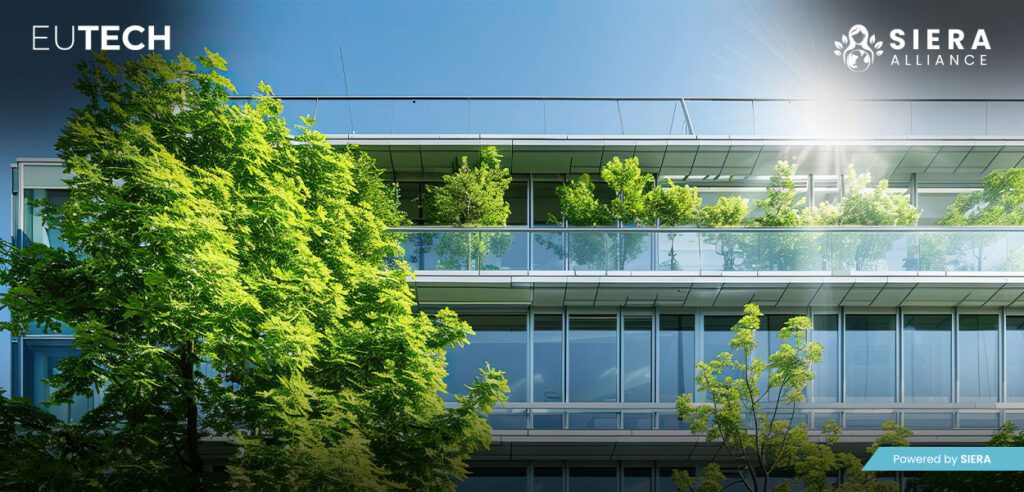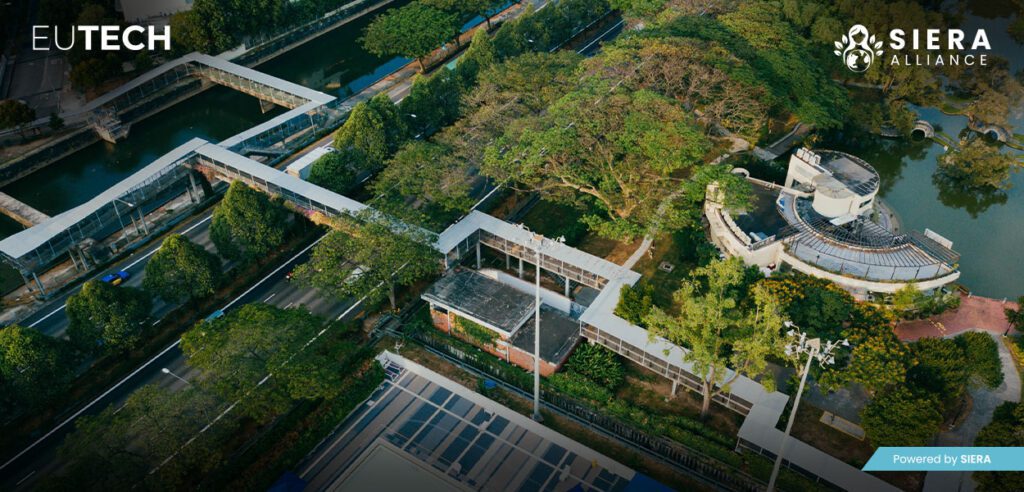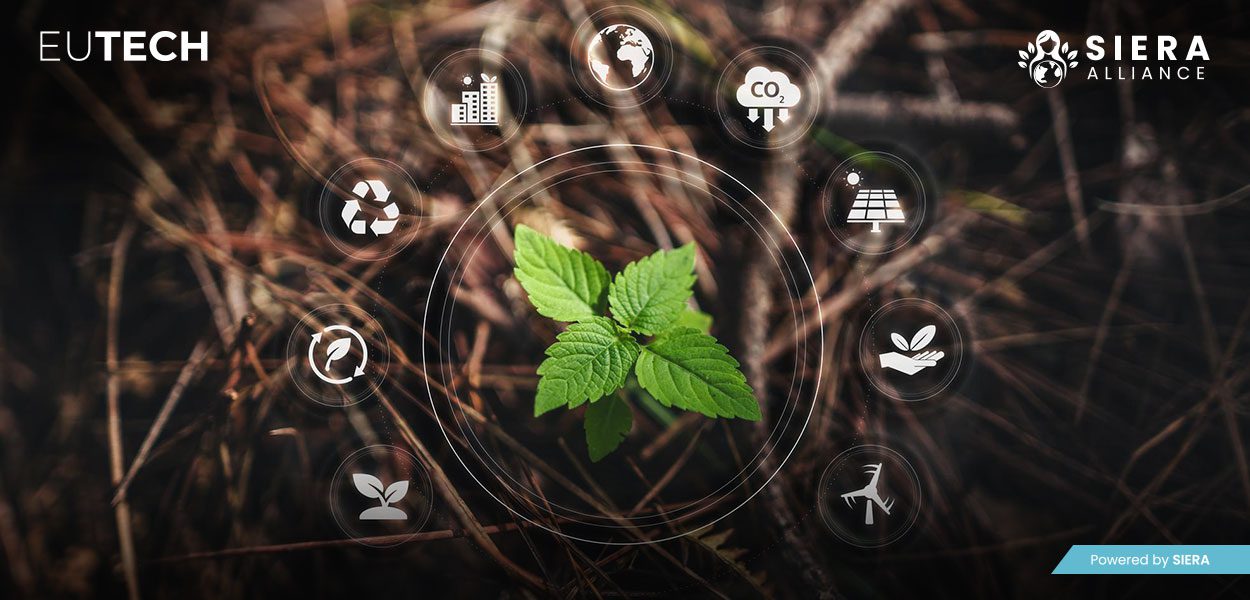What is sustainable construction?
Sustainable Construction is a modern approach that acknowledges the detrimental impact of traditional building practices and attempts to mitigate its effects by adopting greener solutions.
With sustainable development goals mandating change from the construction industry, practitioners are adopting sustainable construction to limit the environmental impact of their operations.
The evolution of sustainable construction
Sustainable construction has been practiced since the Earth hosted its very first civilization. Early human societies relied on natural, renewable materials to build their homes and centuries later, the need for such an approach has returned.
The ideology of sustainable construction was revitalized in the 1970s when disruptions to the global oil trade caused energy crises across the Western world. As a result, architects began designing greener buildings that would consume less energy and create less waste.
Over the next few decades, the advent of technology led to a focus on eco-tech practices, paving the way for the green building technologies at the forefront of modern construction today.
How is sustainable construction defined?
Sustainable construction is an environmentally responsible approach to the design, construction and maintenance of buildings.
As a practice, it attempts to limit any negative impact on the environment by increasing the usage of renewable energy and resources while limiting waste.

What are the key principles of sustainable construction?
Sustainable construction doesn’t just attempt to reduce the detrimental effects of building operations, it also focuses on maximizing the positive impacts of the built environment.
Recent reports like the ‘Building to Net Zero’ scheme and the 2015 Paris Agreement outline 7 key principles behind sustainable construction-
- Sustainable Design
- Durability
- Energy Efficiency
- Waste Reduction
- Indoor Air Quality
- Water Conservation
- Sustainable Building Materials
Sustainable Design
This design philosophy measures the environmental, social and financial impact of architectural decisions to help practitioners land on the most efficient solutions.
Factors like long-term energy performance can help developers understand the sustainability of their projects and make decisions that optimize the long-term functioning of their buildings.
Durability
Lack of durability is among the main criticisms levied against traditional construction practices. By cutting costs on materials, buildings often age quicker, requiring new construction projects to be undertaken.
However, by prioritizing durable materials and practices, the long-term costs of maintaining and renovating old buildings can reduce drastically. Simultaneously, the need for additional land is reduced by constructing more durable buildings as fewer redevelopment projects need to be taken up.
Energy Efficiency
Sustainable construction doesn’t just promote resilience against the passage of time, it also highlights the need for energy efficiency, which results in less consumption of resources.
By accounting for natural light and air, indoor air quality and the effectiveness of insulation, buildings can be constructed in a manner that reduces their energy needs while optimizing their energy usage.
Waste Reduction
This principle applies primarily to the construction phase of projects. Where new builds cannot be avoided, sustainable construction highlights the need for recycled and recyclable materials.
With modern technologies, construction projects can be more circular than ever, functioning in a closed-loop system where waste is reused instead of being sent to landfills.
Indoor Air Quality
Along with environmental impacts, sustainable construction practices also take account of the social impact of buildings.
One of the key areas through which sustainable technologies can improve people’s quality of life is by designing features that facilitate natural ventilation, improving indoor air quality and airflow.
Water Conservation
While conscious designing and plumbing can do a lot for the water consumption of a building, construction operations themselves are infamous for unsustainably using water.
Along with a focus on installing efficient fixtures, sustainable construction services can also contribute materials that are produced in environmentally friendly ways, reducing the overall footprint of projects.
Sustainable Building Materials
Renewable and recyclable materials are growing in accessibility and builders can avail these sustainable construction solutions to reduce the waste they generate.
From selection to production to application, sustainable construction highlights the need for materials that are designed for long-term usage.
Why is sustainable construction relevant today?
The construction industry has consistently accounted for over one third of global CO2 emissions. Concrete, which is the most utilized building material in Germany, contributes to 7% of global CO2 emissions by itself.
As such, the carbon footprint of the construction industry has become one of the major hurdles in the pursuit of carbon neutrality. Since the need for housing continues to grow, developers are challenged to balance the demand in the market with the environmental needs of the hour.
What types of sustainability are relevant to construction?
Sustainable construction isn’t just driven by the tenets of environmentalism. There are three key considerations baked into the practice:
- Environmental sustainability
- Economic sustainability
- Social sustainability
While the adoption of green construction is primarily driven by the need for environmental sustainability, it isn’t the only factor.
At the end of the day, construction companies are businesses, and their decisions are ultimately motivated by the bottom line. This is where economic sustainability comes in.
By promoting a conscious approach to building, sustainable construction practices also make projects more efficient from a financial perspective. Furthermore, by using sustainable materials, developers reduce the long-term costs of maintaining and renovating buildings as green materials are typically more durable and require less up-keep.
The third consideration is that of social sustainability. Construction businesses don’t just develop buildings, they provide homes to people. By being mindful of factors like ventilation, insulation and natural lighting, residents of sustainably constructed buildings benefit from an improved quality of life.
What are the best materials for sustainable construction?
In conjunction with the key principles of sustainable construction, using the right materials is essential to achieving lasting change within the industry. And there are several materials leading the charge in sustainable construction:
- recycled materials
- bamboo
- hempcrete
- reclaimed wood
- alternative bricks
Recycled materials are highly valued for their impact on a building’s carbon footprint. Up to 90% of a project’s carbon footprint can be reduced by sourcing recycled steel and concrete, making them one of the best materials for green construction.
As one of the fastest growing plants in the world, bamboo is another material that is commended for its impact on sustainability. It possesses the strength and durability of regular wood but is much more lightweight, reducing the costs involved in shipping and logistics. Its strength and flexibility also endow bamboo with earthquake-resistant qualities which unlock a new layer of futureproofing for developers.
Another natural material at the forefront of green construction is hempcrete, which is made from hemp shives and a lime-based binder. As a breathable material, this biodegradable alternative to concrete performs incredibly well at insulation, reducing the need for more energy-intensive materials.
Materials like reclaimed wood also promote a circular system within the construction landscape. Instead of sending debris from old buildings to the landfill, the wood can be re-used for various purposes like flooring.
Lastly, natural resources like wool and mud can serve as natural alternatives to traditional brick-making materials. The primary benefit of this approach is that allows developers to make bricks without using a kiln, significantly reducing the carbon emissions caused by their projects.

Three primary techniques for sustainable construction projects
While there are a plethora of services and options that can enable sustainable construction, there are three fundamental technologies at the heart of the approach.
- Green Insulation Materials
- Renewable Energy Systems
- Passive Design Strategies
Green Insulation Materials
Traditional insulation practices employ energy-intensive manufacturing processes which result in a high level of emissions. That’s why green construction practitioners are looking towards alternative methods of insulation, utilizing natural resources like denim and cotton, to reduce the footprint of their projects.
Renewable Energy Systems
A majority of the buildings in Europe were developed before 2000, and more than half of them perform poorly in energy performance metrics. As a result, the utilization for renewable energy systems can drastically improve the long-term efficiency and footprint of construction projects.
Passive Design Strategies
This approach highlights the social element of sustainable construction. By recognizing the fact that the built environment is made for other humans to use, green developers are accounting for natural ventilation, natural light sources and insulation practices while designing their buildings. In the long run, this leads to less energy consumption as patrons of the building can get more out of the natural sources of light and air and rely less on energy-intensive systems.
How can existing buildings become more sustainable?
While sustainable construction practices boast tremendous potential for revolutionizing the industry, the underlying philosophy also highlights the need for retrofitting existing buildings. After all, destroying and re-building structures is one of the most energy-intensive practices in construction.
Instead of rebuilding these older structures, sustainable construction values the materials that have already been used to build them and focuses on retrofitting those structures to meet the environmental performance goals of the present day.
Installing solar panels or green roofs can provide a much-needed boost to old the energy performance of old buildings. Furthermore, renovations to fixtures and appliances can significantly reduce the water and energy consumption of existing buildings, making them more environmentally-friendly in the long and short-term.
What are some sustainable construction practices?
Addressing logistical inefficiencies, lean construction attempts to minimize delays and wastage to maximize the value of construction projects. It’s a collaborative practice that requires all levels of the supply chains to communicate effectively and cooperate to optimize the usage of resources.
Rather than just prioritizing the emissions caused by on-site activities, lean construction focuses on the delivery systems involved in construction projects to improve their efficiency.
Prefab construction on the other hand, reduces the on-site emissions by approaching design and construction with a manufacturing mindset. By assembling factory-built segments and panels into buildings on-site, the final product emits 37% less CO2 than traditionally built houses.
Modular construction follows a similar approach. In this practice, modules of a building are engineered in warehouses, where emissions can be controlled. Thereafter, the modules are shipped to the construction site for energy efficient assembly.
Another practice that is informed by technological advances is circular construction.
Approached with the intention of reducing, reusing and recycling resources wherever possible, this method highlights the need for recyclable materials. Construction waste that would typically be sent to landfills can instead be salvaged and reused to minimize wastage and maximize the efficiency of each utilized resource.
Building Information Modeling achieves a similar goal through different methods. This practice prioritizes the design and preconstruction stages of a building. It values logistical oversight in scheduling, estimation and resource management to ensure that every phase of the project is as efficient as possible.
With the use of modern technologies, information from multiple stakeholders is analyzed in real-time to make decisions that limit the wastage of time and materials.

Does sustainable construction benefit homeowners?
Of course, the environmentally conscious homeowner will be delighted that their sustainably constructed home emits less carbon. But that’s only the tip of the iceberg when it comes to the benefits of sustainable construction in homes.
For one, practices like modular and prefab construction feature drastically shorter turnaround times. This means that owners don’t have to wait as long for their new homes to be constructed.
Secondly, homes with a good energy performance also benefit the bottom line for homeowners. Whether it’s the use of efficient fixtures and appliances or the maximization of natural light and ventilation, sustainably constructed homes require less energy and therefore, generate fewer costs for homeowners.
Lastly, with improved insulation, air quality and access to sunlight, there is no greater benefit for homeowners than the improvement on their quality of life.
How will sustainable construction evolve in the future?
With its potential to disrupt all industries, Artificial Intelligence is also lauded for its potential applications in sustainable construction. AI models trained on data from a building can optimize various functions to reduce energy usage and wastage.
From monitoring the lighting and heating requirements of a finished project to streamlining the logistics of an on-going construction, AI can aid green practitioners in making decisions that utilize their resources most effectively.
AI can also improve the speed of construction projects by ensuring that materials are re-stocked on time and enhance a project’s safety with predictive maintenance of its equipment.
Relevant examples of sustainable construction
Designed in 2014, The Edge is an office building in Amsterdam that is often lauded as the greenest commercial building in the world. With 70% energy savings compared to typical office buildings, it utilizes several sustainable construction practices to limit its environmental impact.
From rainwater harvesting and intelligent lighting systems to the 4,100 square meters of solar panels embedded on its roof, The Edge is a remarkable feat in environmental engineering. That’s why it holds the highest BREEAM (Building Research Establishment Environmental Assessment Methodology) rating of any office building on Earth.
The Eastgate Centre in Harare, Zimbabwe achieves similar environmental benefits through starkly different methods. Completed in 1996, the mixed-use 9-storey building employs largely natural solutions and consumes less than 10% of the energy of a typical structure of its size.
It used only local materials to limit the impact of its construction, and its design continues to mitigate the building’s environmental impact even after thirty years. The walls of the building avoid any direct sunlight and 48 large air ducts are stacked throughout the building to allow for continuous ventilation.
With its natural cooling system, the building eliminates the need for air conditioning which significantly reduces its carbon footprint.
Building in existing buildings
Now that we have explored the potential and promise of sustainable construction, let’s also consider its biggest challenge – land use.
85% of the buildings in Europe were built before 2000. That’s a significant portion of land supporting buildings with below-average energy performance.
Now, practitioners can destroy and re-develop those buildings in pursuit of sustainability. But destroying and rebuilding structures leads to double emissions.
The energy needed to demolish a building is only eclipsed by the dust and pollution left in its wake. Furthermore, plots of land are not as easily available anymore, particularly in metropolitan cities. Deforesting land to create sustainable buildings also goes against the principles of sustainability.
This is where building in existing buildings comes in. By utilizing and retrofitting existing structures with modern technologies, old buildings can be upgraded to meet present-day environmental standards.
At the same time, this practice uses significantly fewer resources, especially energy-intensive materials like concrete, by strengthening and building around the existing structure.
However, even pursuing this radical approach comes with its own challenges. From legal and social concerns to cultural considerations, building in existing buildings is a developing phenomenon which needs to be explored more thoroughly.
In that vein, the EU Tech Chamber is delighted to announce its Bauen im Bestand seminar in Schwetzingen on the 10th of April, 2025.
With this knowledge transfer session, we hope to push the sustainable construction agenda in a new direction and inspire more developers to consider this approach. A panel of interdisciplinary experts will share their professional opinions on how practitioners can navigate the challenges of building in existing buildings.
FAQs
What is sustainable construction?
Sustainable construction is an approach to the built environment that addresses and mitigates the detrimental environmental impact of construction projects.
What are the 3 pillars of sustainability in construction?
Sustainable construction is driven by a commitment to environmental, social and financial sustainability, ensuring that no stakeholders are compromised in the construction of a building.
How to be sustainable in construction?
Achieving sustainability in a construction project requires practitioners to re-imagine several processes in their operations. Passive design strategies, lean delivery systems, green insulation and the sourcing of recyclable materials can make a significant impact on a building’s sustainability.
What are three approaches to sustainability in the construction industry?
Prefabricated construction (which includes modular construction), circular construction and building information modelling are three leading approaches to sustainability.
Why is sustainability important in building construction?
The construction industry accounts for over 1/3rd of the world’s CO2 emissions. Traditional approaches rely on energy-intensive materials like concrete and steel, necessitating a need for greener materials and practices across the industry.







